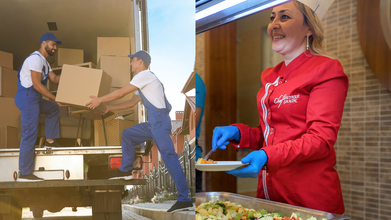- Health Conditions A-Z
- Health & Wellness
- Nutrition
- Fitness
- Health News
- Ayurveda
- Videos
- Medicine A-Z
- Parenting
- Web Stories
Cardiac Arrest Warning Signs Are Not The Same In Men And Women; How To Spot The Warning Signs?

Credits: Health and me
Heart disease remains the leading cause of death worldwide, claiming millions of lives each year. Among its most devastating manifestations is cardiac arrest—a sudden, unexpected stoppage of heart function that, if not treated immediately, is almost always fatal. Recent research has illuminated a crucial, often overlooked fact: the warning signs of cardiac arrest can differ between men and women. Recognizing these differences is not just a matter of academic interest; it can mean the difference between life and death.
Cardiac arrest is often sudden, silent, and deadly — claiming more lives globally than most people realize. But a growing body of research shows that its early warning signs may not be the same for everyone. Specifically, men and women often experience different symptoms before cardiac arrest occurs — and recognizing these differences may mean the difference between life and death.
Sometimes called sudden cardiac arrest, occurs when the heart abruptly stops beating. This cessation halts blood flow to the brain and other vital organs, causing a person to lose consciousness within seconds. Without rapid intervention, such as cardiopulmonary resuscitation (CPR) or use of an automated external defibrillator (AED), death can occur within minutes.
Unlike a heart attack—which is caused by a blockage in the arteries supplying the heart—cardiac arrest is primarily an electrical problem. The heart’s rhythm becomes dangerously abnormal, most commonly due to ventricular fibrillation, causing it to quiver instead of pumping blood effectively.
A recent study published in The Lancet Digital Health has revealed groundbreaking findings that could reshape how we understand and respond to cardiac arrest. Researchers have now confirmed that while chest pain is the most prominent pre-symptom in men, women often experience shortness of breath in the hours leading up to a cardiac arrest episode. The data comes from community-based studies including the PRESTO study in California and the SUDS study in Oregon, which collectively examined how sex-specific symptoms could be harnessed to improve early detection and survival.
According to the study, half of all individuals who experience sudden cardiac arrest have a warning symptom within 24 hours prior to the event. However, these symptoms are not uniform across genders. For women, shortness of breath emerged as the most prominent warning sign, while men most commonly reported chest pain. Other symptoms, such as palpitations, flu-like sensations, and even seizures, were also noted in a smaller subset of patients.
Shortness of Breath vs Chest Pain
In the recent study, researchers found that over 50% of individuals who suffered cardiac arrest had at least one warning symptom within 24 hours. Men most commonly reported chest pain, while women more frequently experienced shortness of breath. A smaller percentage of both groups experienced palpitations, flu-like symptoms, or seizures.
“This is the first community-based study to evaluate sex-specific warning symptoms using real-time emergency medical service (EMS) documentation,” said Eduardo Marbán, Executive Director at the Smidt Heart Institute.
Dr. Sumeet Chugh, the study’s lead investigator, emphasized the impact: “Harnessing these symptoms could guide who needs immediate emergency response. That insight could change survival rates.”
What Exactly Is Cardiac Arrest?
Cardiac arrest, sometimes confused with a heart attack, occurs when the heart stops beating abruptly due to an electrical malfunction. This sudden stoppage halts blood flow to the brain and other vital organs, often causing loss of consciousness within seconds. If not treated immediately — typically through CPR or defibrillation — death can occur within minutes.
It’s different from a heart attack, which is caused by a blockage in the coronary arteries. However, heart attacks can trigger cardiac arrest by disrupting the heart’s electrical system.
Cardiac Arrest vs. Heart Attack
The terms “heart attack” and “cardiac arrest” are often used interchangeably, but they refer to distinct medical emergencies. A heart attack is caused by a blockage that prevents blood from reaching a part of the heart muscle, leading to tissue damage. Cardiac arrest, on the other hand, is an electrical malfunction that causes the heart to stop beating altogether.
While a heart attack can increase the risk of cardiac arrest—by disrupting the heart’s electrical system—not all cardiac arrests are preceded by a heart attack. Other causes include arrhythmias, enlarged heart (cardiomyopathy), severe blood loss, valvular heart disease, and electrolyte imbalances.
Why Younger People Are at Increasing Risk?
The rise in sudden cardiac deaths among young adults is particularly concerning. While some cases are linked to undiagnosed heart conditions such as hypertrophic cardiomyopathy or ventricular arrhythmias, others may be triggered by intense exercise, drug use, or even severe viral infections. These factors can cause the heart to beat irregularly or stop altogether, often without warning. Several factors are contributing to the alarming rise in heart disease and sudden cardiac arrests among young adults:
Genetics and lifestyle: While you can’t change your genes, factors like smoking, poor diet, lack of exercise, and unmanaged stress play significant roles in heart health.
Steroid abuse: Especially among gym-goers and bodybuilders, the use of steroids and growth hormones can damage heart muscles and disrupt rhythms.
Undiagnosed conditions: Conditions like hypertrophic cardiomyopathy or dilated cardiomyopathy (often linked to viral infections like COVID-19) may go unnoticed until it's too late.
Post-COVID heart risks: Myocarditis and lung fibrosis can lower oxygen supply and impair heart function, increasing cardiac vulnerability.
Severe stress: Though rare, emotional trauma can induce cardiac events, especially in those with pre-existing conditions.
Recognizing the Symptoms Before It’s Too Late
For women, these symptoms may present more subtly — and are more likely to be mistaken for stress or anxiety. That’s why public health messaging must evolve to include gender-specific information. While some cardiac arrests strike without any warning, many cases are preceded by symptoms that are often misread or dismissed:
- Chest pain or tightness
- Shortness of breath
- Palpitations or irregular heartbeat
- Fainting or dizziness
- Extreme fatigue
- Nausea or stomach pain
- Sudden sweating or lightheadedness
What You Can Do Today to Prevent Cardiac Arrest?
Preventing cardiac arrest begins with understanding your risk factors and taking proactive steps to protect your heart health. Experts recommend the following:
Routine screening: Start annual checks for blood pressure, cholesterol, and blood sugar levels after age 18.
Know your numbers: Aim for total cholesterol <200 mg/dL, LDL <100 mg/dL, fasting glucose <100 mg/dL, and blood pressure <130/80 mmHg.
Get vaccinated and treated for viral infections: Viruses like COVID-19 can lead to myocarditis and long-term heart damage.
Stop smoking and avoid exposure to secondhand smoke.
Maintain physical activity but with caution. People over 40 or with a family history should consult a doctor before starting high-intensity workouts.
As cardiac events among young people rise and symptoms continue to vary across genders, researchers believe integrating biometric data, wearable tech, and AI-powered health tools can offer early detection solutions in the near future.
These Silent Habits Could Be Destroying Your Organs, According To Surgeon

(Credit-Canva)
We all make mistakes, however, not all of them can be fixed. Many times, things we thought were harmless could create a big mess for us. An orthopedic surgeon on Instagram listed 8 mistakes that we make that are harming our health.
Many things we do every day without thinking can actually cause serious damage to our bodies over time. Dr. Manan Vora, an orthopedic surgeon, recently shared advice on habits that quietly hurt our organs and what we should watch out for to stay healthy.
He points out that simple actions like mouth breathing, sitting too much, or listening to loud music can affect your health in big ways. Being aware of these habits and making small changes can help protect your organs and improve your overall well-being.
Lungs: Stop Mouth Breathing
Breathing through your mouth instead of your nose can dry out the important tubes in your lungs. This dry environment makes you more likely to catch colds and other infections. Over time, mouth breathing can cause long-term breathing problems and makes it harder for your body to get enough oxygen. Try to practice breathing through your nose.
Heart: Avoid Long Sitting Periods
When you sit down for many hours without moving, the blood flow in your body slows down a lot. This lack of movement forces your heart to work harder, putting extra stress on it over time. To protect your heart, you should set a timer and make sure to get up to stretch or take a short walk for a few minutes every single hour.
Eyes: Don't Rub Them
Rubbing your eyes might feel like a comfort when they itch or feel tired. However, this action can be harmful. Rubbing can easily introduce germs from your hands into your eyes, leading to infections. Worse, it can cause tiny scratches on the clear front part of your eye, which could lead to long-term vision problems.
Stomach: Slow Down Your Eating
If you eat your meals too quickly or constantly eat too much food, it can seriously upset your stomach and digestion. The stomach needs time to break down food efficiently. To help your stomach, make sure you chew your food properly, enjoy your meal slowly, and try to stick to smaller, more reasonable portions throughout the day.
Liver: Skip Heavy Late-Night Meals
Eating a big, rich meal right before you go to bed puts a huge workload on your liver while it should be resting. This nighttime feasting can also slow down your metabolism, making it harder for your body to process energy. It is much better for your liver if you finish your dinner at least two to three hours before you sleep.
Kidneys: Stay Hydrated
Your kidneys work hard to clean your blood, but they need enough water to do their job correctly. If you don't drink enough water and become dehydrated, it can cause severe strain on your kidneys. This dehydration also greatly increases your risk of developing painful kidney stones. Drink water consistently all day long to keep your kidneys healthy.
Brain: Focus on One Task
Doing several things at once, known as multitasking, might feel like you're getting more done, but it actually hurts your brain. Constantly switching your attention reduces your focus and makes your memory weaker over time. The expert suggests that you will be more productive and your thinking will improve if you focus all your attention on completing just one task before moving on to the next.
Ears: Lower the Volume
Regularly exposing your ears to very loud music, especially through headphones, can damage the delicate parts inside your ear. This is not temporary damage; it can lead to permanent hearing loss over time. To keep your hearing safe, always keep the volume at a moderate level and give your ears breaks from noise whenever possible.
Who Is Eligible For The COVID Vaccine Or Autumn Booster In The UK?

Credits: Canva
Who is eligible for covid shot 2025: This year, there has been a “significant change” in who can get the COVID vaccine, according to Community Pharmacy England (CPE). The updated eligibility rules have caused confusion among the public and, in some cases, led to abusive behaviour towards pharmacy staff. Pharmacy teams report that up to half of the patients booked through the NHS National Booking Service (NBS) aren’t eligible, while some ineligible individuals have been sent by their GPs. The National Pharmacy Association (NPA) describes the situation as “deeply frustrating” for both patients and pharmacists.
Who Is Eligible for the COVID Vaccine In the UK This Winter?
This winter, the NHS is offering the COVID vaccine to:
- People aged 75 and over
- Anyone aged six months to 74 with a weakened immune system
- Residents of care homes for older adults
Getting vaccinated this autumn helps protect against serious illness from COVID over the winter months.
How to Book the Vaccine?
Eligible individuals are encouraged to book via the NHS online booking service or the NHS app. People aged five and over who are eligible can also walk into a vaccination site without an appointment. Those who don’t meet the criteria can still get the vaccine privately.Flu Jab Eligibility
More people qualify for the flu jab, including:
- Those over 65
- People with long-term health conditions
- Pregnant women
- All primary school children
- Secondary school children in years 7–11
- Frontline healthcare workers
- Care home residents
- Certain carers or people living with someone with a weakened immune system
Why Are Some Booking Errors Happening?
Confusion has arisen because the online system allows patients to book COVID and flu vaccines at the same time. Henry Gregg, chief executive of the NPA, said:
“This situation should have been avoidable and is very frustrating for both pharmacies and patients. We ask that patients treat pharmacy staff with respect as they navigate the new NHS rules. We’ve raised the issue with NHS England and the Department of Health and hope for a quick resolution.”
What Is the Autumn Booster?
By autumn, protection from earlier COVID vaccines can start to wane. For those at higher risk of severe illness, the NHS provides a free autumn booster.
The current vaccines continue to provide strong protection against hospitalisation and serious disease. Data from UKHSA shows that people who received a booster last autumn were around 43% less likely to be admitted to hospital with COVID-19, starting two weeks after vaccination, compared to those who remained unvaccinated.
Work On Your Feet All Day Long? Doctor Reveals 3 Rules To Protect Your Leg Health And Prevent Burnout

Many of our essential workers work on their feet all day long. People in the service industry also often work for long hours with no breaks, let alone resting their feet. However, is that healthy?
Studies like the 2015 research published in the Rehabilitation Nursing journal spending too much time standing at work can severely affect your life. It can lead to problems like lower back and leg pain, potential issues with your heart and blood flow, feeling of fatigue or extreme tiredness, and general discomfort, etc.
However, you cannot abandon your responsibilities - and so how can you protect your health? To help people who might face these issues, Dr. Rema Malik, Board certified specialist in Vascular Surgery, released a video detailing her ‘non-negotiable rules’ that protect her leg health as well as help her combat burnout.
In the post caption, Dr Rema explained, “For every nurse, teacher, stylist, and chef in Houston, here are my top 3 non-negotiable rules from a vascular surgeon to protect your leg health and prevent burnout. You spend 8, 10, even 12 hours a day on your feet, taking care of everyone else. By the time you get home, your legs are aching, heavy, and swollen. This is not "just part of the job."”
To help these workers not just get through their shifts but also protect their long-term health, Dr Rema has offered three essential, non-negotiable rules for better leg health.
Rule 1: Make Compression Your Essential Gear
Compression is Your Uniform. This is the single most important thing you can do, and it is not optional. You must wear medical-grade compression socks (15-20 mmHg) every single day.
Why it works: These socks are your first and best defence against the constant downward pull of gravity. They gently squeeze your legs, which helps your veins push blood back toward your heart. The socks also help stop blood from pooling and prevent the damage that leads to heavy, swollen legs.
Rule 2: Take a Mid-Shift Reboot
The Mid-Shift Reset. During your break, you must find just two minutes to perform a mandatory reboot for your legs. Don't just sit down.
What to do: Do 20 deep calf raises - which means standing on your toes, and 10 ankle rotations in each direction.
Why it works: Your calf muscles are often called your "second heart." These exercises squeeze your veins and immediately pump out the stagnant blood that has pooled in your lower legs, giving you a quick relief.
Rule 3: Drain Your Legs After Work
The 10-Minute Post-Shift Drain. The second you walk through the door after your shift—before you start cooking, cleaning, or sitting on the couch—you need to lie down for a bit.
What to do: Lie on the floor and prop your legs straight up against a wall for at least 10 minutes.
Why it works: This simple act immediately reverses the gravitational pull of the entire workday. It provides instant relief and helps drain any fluid that has built up, which is crucial for long-term vein health.
Following these three rules is important at any age, but it becomes absolutely essential after 30 years. By taking these steps, you prevent the constant stress that leads to chronic venous insufficiency and painful varicose veins.
© 2024 Bennett, Coleman & Company Limited

